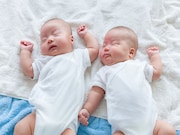Four percent decrease to 32.6 twins per 1,000 total births marked lowest rate in more than a decade
THURSDAY, Oct. 3, 2019 (HealthDay News) — From 2014 to 2018, there was a decrease in the twin birth rate, according to an October data brief published by the U.S. Centers for Disease Control and Prevention National Center for Health Statistics.
Joyce A. Martin, M.P.H., and Michelle J.K. Osterman, from the National Center for Health Statistics in Hyattsville, Maryland, explored trends in twin childbearing for 1980 to 2019 overall and by maternal age, race, Hispanic origin, and state of residence for 2014 to 2018.
The researchers found that the twin birth rate decreased 4 percent during 2014 to 2018 to 32.6 twins per 1,000 total births in 2018, reaching the lowest rate in more than a decade. The number of births in twin deliveries decreased by an average of 2 percent per year from 2014 through 2018, declining to 123,536 births in 2018. Among mothers aged 30 years and older, twin birth rates decreased, with the largest decrease among older mothers aged 40 years and older. From 2014 to 2018, there was a 7 percent decrease in the twinning rate in non-Hispanic white mothers, while the rate was essentially unchanged among non-Hispanic black and Hispanic mothers. In 17 states, there were decreases in twin birth rates, while increases were seen in three states.
“For the first time in more than three decades, from 2014 through 2018, the twin birth rate for the United States trended downward,” the authors write.
Copyright © 2019 HealthDay. All rights reserved.








